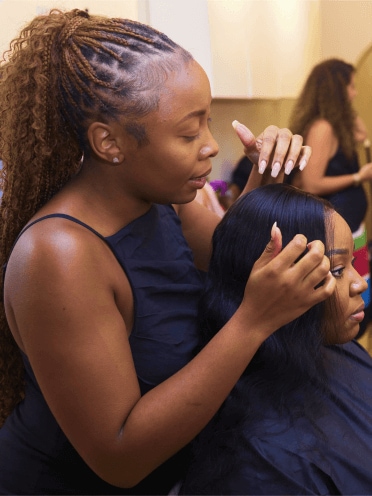
Microlocs: Here's Your Complete Guide
Protective styles such as sister locks and microlocs are growing in popularity thanks to the minimal effort required to style and maintain them after installation.
What are microlocs?

Microlocs are small, tight braids, usually less than half an inch in diameter. They work best on odd or curly hair textures, which are then secured with crochet or interlock techniques.
Microlocs installation is similar to traditional locks. It begins with twisting, weaving or coiling, and then wax or balm is applied to the area to promote locking.
Making micro-locks does not require any formal training to complete. Depending on your hair growth rate, you may need to maintain your locks after every 4-8 weeks to keep the hair shaft tight. Microlocs can be maintained using interlock or palm-rolling techniques.
Micro curls can also be started with braids, double-strand twists, coils or palm-rolling hair. Each method can produce different results, so consult a professional before you begin.
Are microlocs right for you?
While microlocs have many benefits, they require more cost and time for smaller microlocs. So when considering whether microlocs are right for you, I highly recommend considering the following factors.
● Active lifestyle.
If you have an active lifestyle and can keep your latches tidy for longer periods of time, or if you like to wash your hair frequently, then you should consider microlocs.
● Maintenance costs.
If your budget includes a trip to the salon to pay for your hair, you should consider microloc maintenance, whether it's interlocking or palm rolling. However, if you would rather maintain your locks at home, you should consider palm rolling to maintain larger microlocs.

● Time to maintain.
Generally, microlocs are going to be over 100 locks, and the time required to maintain this number of locks can be a lot, especially if you are interlocking. You have to make sure you can put in at least 6-8 hours every few months.
● Quantity and fullness.
The more locks you have, the less scalp you'll be exposed to, which will give you fullness. So, if your goal is fullness, micro-locks are definitely an option to consider.
● Interested in sisterlocs.
If Sisterlocks are too small and you prefer smaller-sized Locs, microlocs are a great option.
Advantages and disadvantages of microlocs
Advantages of microlocs

● Very easy to install.
Microlocs do not require any expertise in installation, and you can even install them yourself. The installation time is short when doing the coil technique, between 2 and 4 hours. But it totally depends on the speed of your hair stylist and the size of your hair.
● Low installation cost.
Microlocs are often cheaper than sister locks, mainly because they do not require certification or specific products to install and manage.
● Low maintenance costs.
When it's time to retighten your latch, it's easy to do at home and doesn't require special tools or training, depending on the method of installation.
Disadvantages of microlocs
Since there is no defined grid pattern, it can lead to asymmetrical locks and uneven parting.
Since it does not require any training, it can lead to mistakes and even holes along the hair strands, which can lead to hair breakage.
Shaping micro-curls can be difficult. Also, the longer they are, the heavier they get, which affects your ability to style them.
It is possible to make mistakes. Since no formal training is required to install microlocs, mistakes can lead to uneven locking or breakage.
May unlock or lump. Before the microlocs are fully locked, they may unravel or clump together, which requires repair to avoid undesired results.
What do microlocs look like?

While microlocs and sisterlocks have a lot in common and often look similar, there are a few differences in their appearance.
Sister locks have more locks per square inch, giving the sister lock a tighter, dense appearance. Typically, there are at least 400 sisterlocks, while microlocs have at least 150.
While microlocs may look similar to larger locks when they are new, they increase in size or become thicker as they age, making them heavier and more difficult to style. Sister locks, on the other hand, remain the same uniform size.
Key differences between microlocs and sisterlocs
Sister locks are often compared to micro locks because both divide the hair into small sections and secure each section with a tool. However, there are some distinct differences between the two.
The biggest difference between microlocs and sisterlocs is the cost. microlocs usually start at $200, while sister locks cost at least $500, depending on the length and density of the hair and whether the location is a trainee or certified consultant.
Another big difference is the amount of time it takes to do each hair type. microlocs usually take about 8-20 hours to install, while sisterlocs can take up to 3 days.
A sisterlocs consultant will install a series of test locks prior to a full installation. The test locks determine the best pattern for the client's hair. The consultant will then install sisterlocs in the identified rows and columns.
Can you turn a sisterloc into a microloc?

Yes, you can turn a sister lock into a floret, but this is irreversible. Ideally, once a sisterloc matures, you can transform it into a florescence by merging the two locks and interlocking them together, or by rolling it with your palm at the root.
Which is better, microlocs or sisterlocks?
If you want a more affordable option with less commitment, then the microlocker may be the way to go for you. However, if you're willing to invest time and money into a long-term style, then sister locks may be the better option.
How to install microlocs?
The installation of Microlocs is short and should take between 6 and 20 hours if done by a professional. How long it takes will depend on how it is locked. If you do it yourself, it can take up to a week!
Installing Microlocs can be done in a variety of ways. You can weave, coil, interlock, or twist them to get started. There are good and bad ways to do each of these. You should do some research before making a choice.
The best thing about microlocs is that anyone can do it. You can even do it yourself while you're at home. It can be difficult when you install the microloc yourself because it takes a long time and a lot of muscle work.
You can twist the two brackets together to make larger strands in the future. The twisting process is not very difficult. It helps to maintain the style.
When using the coil method, the installation time is shorter, between two and four hours. However, it totally depends on how fast your stylist works and how big your hair is.
Types of Microlocs

Micro-locks come in all shapes and sizes. Interlocks, braids, and twists are the most common ways to start a microloc. However, microlocs can also be started with a plate, but this is not as common.
Interlocking is the start of a microloc.
Starting microlocs using interlocking is ideal for fine-textured hair or those who want the finest microlocs.
Braids are the start of microlocs.
When you have very long hair at the time of installation, or if you have fine hair and the twist won't hold, it is typical to start microlocs with a braid.
Twist braids are the beginning of Microlocs.
microlocs starting from twists are good for medium to large microlocs that hold well in all hair types. microlocs starting from twists have the advantage of being large enough to hold with interlocking or palm rolling.
Read More:
Butterfly Cut-Add Volume And Texture To Your Hair

























Submit Your comment